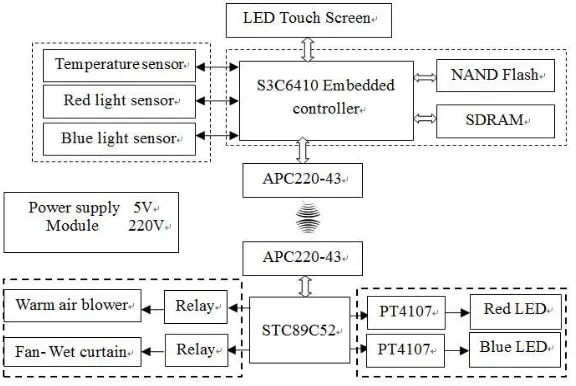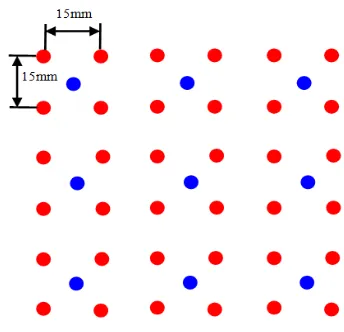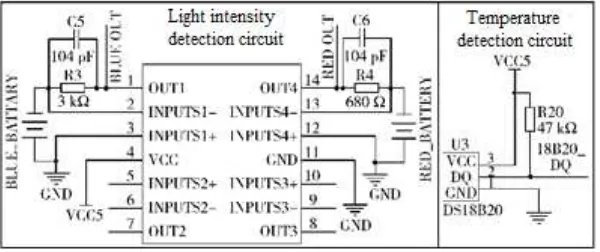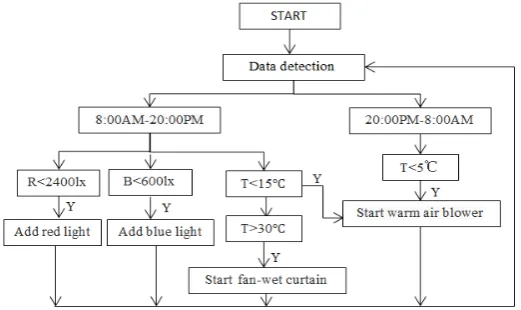DOI: 10.12928/TELKOMNIKA.v13i3.1973 752
An Intelligent Supplementary Lighting System for the
Strawberry Greenhouse
Zhiliang Kang, Lijia Xu*, Fei Xiao
College of Mechanical and Electrical Engineering, Sichuan Agriculture University, Ya’an, China *Corresponding author, e-mail: lijiaxu13@163.com
Abstract
An intelligent supplementary lighting system for a strawberry greenhouse is developed in this study using the embedded controller S3C6410 as core. This system detects the temperature and lighting information of the strawberry greenhouse with the temperature sensor DS18B20 and the lighting sensor 2DU6. It stores, displays, analyzes, and processes the collected information with S3C6410 and transfers the control commands to STC89C52 through APC220-43. Thus, it realizes temperature regulation of the strawberry greenhouse and intelligent supplementary lighting of red–blue LED combined lights. The test result shows that this system not only realizes supplementary lighting as required and by wave bands, but also saves electric power. This system has distinctive features of strong applicability, good expandability, stable and reliable operation, and visual and simple control.
Keywords: strawberry greenhouse, intelligent supplementary lighting, LED combined light, embedded controller
Copyright © 2015 Universitas Ahmad Dahlan. All rights reserved.
1. Introduction
Light is an important environmental factor for the growth of plants. It regulates and controls the growth of plants and the quality of fruits. Lighting conditions include intensity, quality, and duration. Photosynthesis takes place within the range of visible spectrum (380 nm to 760 nm). The 400 nm to 520 nm blue–violet light and the 600 nm to 700 nm red–orange light contribute most to photosynthesis [1-3]. At present, the main study direction of artificial light source is the individual regulation and control functions of red, blue, and red–blue lights to aspects such as growth, photosynthesis, substance metabolism, and gene expression of plants.
Therefore, accurately grasping the lighting information is the prerequisite for scientific cultivation in a greenhouse environment. With the progress of science and the development of agricultural technology, the application of artificial light or supplementary lighting sources in agricultural production is rapidly developing. In recent years, incandescent, fluorescent, sodium, and high-pressure mercury lamps with large energy consumption are commonly used to improve greenhouse lighting. Based on statistics, 35% of the energy consumed by global agricultural production annually is used for the facilities horticulture industry, and the energy cost constitutes 15% to 40% of the total cost of greenhouse crops. Thus, the energy consumption is significant and not eco-friendly [4-6].The intensity of light cannot be adjusted based on the intensity of natural light, and a suitable temperature must always be maintained.
2. Overall Design
An intelligent supplementary lighting system for the strawberry greenhouse is designed in this study. This system consists of detection modules, embedded controller and its application circuit, LCD touchscreen, wireless data transfer module, SCM, temperature control device, and LED combined light and its driving circuit. The detection module consists of temperature sensor DS18B20, 600 nm to 700 nm red light sensor, and 400 nm to 500 nm blue light sensor 2DU6. An embedded small system application circuit is composed of a S3C6410 embedded controller, a 2 GB SDRAM connected by two pieces of K4X1G163PC-FGC6 memory, and a 16 GB NAND Flash connected by a piece of K9GAG08U0E-S memory. It collects, stores, analyzes, and processes lighting information. The LCD touchscreen displays the detected data and is used for touch control of the intelligent supplementary lighting system by employing the AT070TN83V1 module. The S3C6410 embedded controller generates temperature and lighting control commands and data based on the environmental parameters and the set threshold value of the strawberry greenhouse and transfers them to the STC89C52 SCM through the wireless data transfer module APC220-43. The STC89C52 controls the relay to switch on the heater or fan-wet curtain so that appropriate temperature of the strawberry greenhouse is maintained. When the lighting in the greenhouse is insufficient, the STC89C52 generates PWM signals that drive the chip PT4107 to change the output current, thus controlling the lighting intensity of the red– blue LED combined light. The detailed structure of the intelligent supplementary lighting system for the strawberry greenhouse is shown in Figure 1.
Figure 1. Overall structure of the intelligent supplementary lighting system of the strawberry greenhouse
3. Design of Combined LED Light Source
This design employs PHILIPS Luxeon Rebel model red or blue UHB LED. All their half-intensity angles are 62.5°. The central wavelength of the red LED is 650 nm, the minimum luminous flux is 40 lm, and the operating current is 350 mA. The central wavelength of the blue LED is 470 nm, the minimum luminous flux is 30 lm, and the operating current is 350 mA. The LED works 50000 h at 25 °C and has a high lumen keeping rate. Thus, it can ensure better stability of output lighting intensity.
Given the high directivity of LED, even R/B proportion on an irradiation area can be realized only with a reasonable array design.
The proportion of red and blue LEDs employed in this study is 4:1. The spacing of the red LED is 15 mm and that of the blue LED is 30 mm. In practical applications, the quantity of LED light depends on the size of the strawberry greenhouse. The array of the red–blue LED combined light is shown in Figure 2.
Figure 2. the array of red-blue LED combined light
(a) 3D distribution diagram of irradiance of blue light
3D distribution diagram of irradiance of red light
Figure 3. 3D distribution diagram of irradiance of red and blue light
source on the plane of illumination is crucial. It guarantees relatively even illumination, ensures that each leaf and the entire plant receive even lighting to the maximum extent, and reduces artificial errors and effects caused by the light source.
4. Design of the Intelligent Supplementary Lighting System
The design of the intelligent supplementary lighting system consists of two parts: hardware circuits and software. The hardware circuits are composed of detection modules, embedded controller S3C6410, LCD touchscreen, wireless data transfer module APC220-43, SCM STC89C51, temperature control device, and red–blue LED combined light and its driving circuit; the software design includes embedded controller S3C6410, SCM STC89C51 program design, and intelligent complementary lighting strategies.
4.1. Design of the Hardware Circuits
The detection modules are classified into three: temperature, red light intensity, and blue light intensity. Their circuits are shown in Figure 4. The temperature sensor DS18B20 and its standard regulating circuit perform temperature detection, and the 600 nm to 700 nm wavelength red light sensor 2DU6 and the 400 nm to 500 nm blue light 2DU6 are used as the sensing devices for red and blue lights. The four-channel operational amplifier LM324 is employed, and the small signal standard I/V converting and filter circuits are applied to convert and amplify the short-circuit current of the detected two-channel silicon photocells. The regulated two-channel analog signals are imported into the I/O port of the embedded controller with ADC function to realize lighting intensity detection by wave band. The system employs sampling resistances with different resistance values to ensure that the detected output voltage of both the red and blue lights is 0 V to 5 V.
Figure 4. Temperature and lighting detection circuit
The red–blue LED combined light employs a two-channel constant current driving circuit and utilizes the PWM control technology to separately control the brightness of red and blue light LED supplementary lighting sets [11-14]. The embedded controller S3C6410 automatically calculates supplementary lighting amount based on the environmental parameters of the strawberry greenhouse and the set threshold value. It transfers the data to the SCM STC89C52 through the wireless data transfer module APC220-43. The SCM generates PWM signals and utilizes the duty ratio to change the output current of the driving module PT4107, thus controlling the red and blue LED combined light to supplement the requirement of detecting light by wave band. The principle of the LED driving circuit is shown in Figure 5.
Figure 5. LED driving circuit
4.2. Design of the Software
The software design of the strawberry greenhouse intelligent supplementary lighting system includes program design of the embedded controller S3C6410 and SCM STC89C51 and intelligent supplementary lighting strategies.
The program design of the embedded controller S3C6410 includes sensor analytic function, data management and decision making, touchscreen interface, wireless data receiving and sending, and parameter setting programs. The program design of the SCM includes wireless data receiving and sending, PWM signal control, display, and temperature control equipment programs.
The temperature, lighting parameters, data sampling period, supplementary lighting time, and working time of the temperature control equipment of the strawberry greenhouse can be set and changed using the LCD touchscreen. The embedded controller S3C6410 collects the temperature and lighting information of the detection module. Supposing the supplementary lighting time is set at a total of 12 hours from 8:00 AM to 8:00 PM, the data sampling period is set as 20 min; light is not supplemented in the remaining 12 hours, and the data sampling period is set as 30 min. The suitable growth temperature for strawberry is 18 °C to 25 °C. When the temperature is below 15 °C from 8:00 AM to 8:00 PM, the heater will be started for 30 min. If the temperature is above 30 °C, the fan-wet curtain will be started for 30 min. Supplementing light from 8:00 PM to 8:00 AM of the next day is unnecessary. However, the strawberry must be prevented from freezing in the greenhouse. Thus, the temperatures are detected once every 30 min. When the temperature is below 5 °C, the heater will be automatically started for 30 min.
Detection by wave band is employed, and the supplementary lighting effect improves when the ratio of the red and blue LEDs is 4:1. The intensity of the red and blue lights is detected from 8:00 AM to 8:00 PM. When the intensity of the red light is lower than 2400 lx, it will automatically supplement the red light so that its intensity reaches 2400 lx. When the intensity of the blue light is lower than 600 lx, it will automatically supplement the blue light so that its intensity reaches 600 lx. Sunlight at noon is favorable, and the threshold values are set for the intensity of the red and blue lights. Thus, the supplementary lighting system stops the supplementary lighting at this time. The work flow of the intelligent supplementary lighting system is shown in Figure 6.
5. System Testing
This system is installed and tested in strawberry greenhouses of the strawberry planting base of Shuangliu County, Sichuan Province. Two strawberry greenhouses of the same size at the same location are employed in the test. One is installed with the intelligent supplementary lighting system, and the other is not. The greenhouse has a length of 30 m, a width of 8 m, and a height of 2.5 m. The installation height of the heaters is 0.5 m, the spacing of the heaters is 7.5 m, and the heaters are 3.75 m away from both sides of the greenhouse. The wet curtain is installed in the middle side of the long side of the greenhouse, and the fan is installed opposite to the wet curtain and 2 m above the ground. The red–blue LED combined light is installed 1 m above the ground. The quantity of the LED light sets is calculated based on the area of the greenhouse and the LED array, and the R/B of each set of light is 4:1. During the test, the intelligent supplementary lighting time is set as 8:00 AM to 8:00 PM, the temperature is set as 15 °C to 30 °C, and the lower temperature limit in the night is 5 °C. The sampling period at daytime and at night is set as 20 and 30 min, respectively. Figure 8 shows the comparison test curve of the red light intensity, blue light intensity, and temperature of the two strawberry greenhouses in 12 h from 8:00 AM to 8:00 PM.
Figure 7. Curve graph of comparison test
It is obvious from the Figure 7 that R0, B0, T0 is the red light intensity, blue light intensity and temperature of the strawberry without this system; R1, B1, T1 is the red light intensity, blue light intensity and temperature of the strawberry with this system.Figure 7 shows that the red light intensity of the greenhouse without the intelligent supplementary lighting system is below 2400 lx during two periods: 8:00 AM to 12:40 PM and 4:20 PM to 8:00 PM. However, the sunlight is favorable from 1:00 PM to 4:00 PM. Thus, the red light intensity in such period is above 2400 lx. By contrast, the red light intensity of the other strawberry greenhouse with the system is approximately 2400 lx in two periods: 8:00 AM to 12:40 PM and 4:20 PM to 8:00 PM. Given that supplementing light from 1:00 PM to 4:00 PM is unnecessary, the red light intensity of both greenhouses is the same. From 8:00 AM to 10:20 AM and 5:40 PM to 8:00 PM, the blue light intensity is below 600 lx, and the strawberry greenhouse with this system realized supplementary lighting as required. Given that the temperature from 8:00 AM to 10:40 AM is low, the temperature of the strawberry greenhouse without this system is below 15 °C. To obtain
0
10:00 10:40 11:20 12:00 12:40 13:20 14:00 14:40 15:20 16:00 16:40 17:20 18:00 18:40 19:20 20:00
a suitable supplementary lighting temperature for the strawberry, the greenhouse with the intelligent supplementary lighting system started the heater for 30 min at 8:00 and 9:40 AM. With the supplementary lighting, the temperature of the strawberry greenhouse with the intelligent supplementary lighting system remained stable above 15 °C.
6. Conclusion
This study proposes an intelligent supplementary lighting system for the strawberry greenhouse using the embedded controller S3C6410. This system controls the temperature and intelligent red and blue lights of the strawberry greenhouse by wave band as required. It also analyzes the influence of the red–blue LED combined light array on the evenness of the complementary lighting of the strawberry greenhouse, and the array whose R/B is 4:1 with the best lighting evenness is selected.
The system satisfies the lighting that is required for the growth of strawberry and improves the utilization rate of the output light to the maximum degree. Thus, the requirement of intelligent and accurate supplementary lighting for different growth periods and environments of strawberry is satisfied. All types of parameters in this system can be freely set based on the experience and habits of crops. Therefore, this system can be conveniently transformed to conduct intelligent supplementary lighting for crops other than strawberry. The test result proves that this system not only realizes supplementary lighting as required, but also saves electric energy. This system has the distinct features of strong applicability, good expandability, stable and reliable operation, and visual and simple operation and control.
Acknowledgements
The research work was supported Key Projects in Sichuan Province Department of Education No. 15ZA0019.
References
[1] Silva Marcos VG, Enes Adilson, Fabbro Incio MD, et al. Development of a new method for volume measurement based on moir techniques. INMATEH - Agricultural Engineering. 2014; 44(3): 87-92. [2] ZHU Jing-xian. Influence of Artificial Supplement of Light on Plant Growth and Development. Crop
Research. 2012; 26(1): 74-78.
[3] Yang Qichang, Xu Zhigang, Chen Hongda. Application Principle and Technology Progress in Using Light-Emitting Diode(LED) Light Sources in Modern Agriculture. Journal of Agricultural Science and Technology. 2011; 13(5): 37-43.
[4] Yang Jiaqiang. An Intelligent Greenhouse Control System. TELKOMNIKA Indonesian Journal of Electrical Engineering. 2013; 11(8): 4627-4632.
[5] Liai Gao, A Wireless Greenhouse Monitoring System Based on Solar Energy, TELKOMNIKA Indonesian Journal of Electrical Engineering. 2013; 11 (9): 5448-5454.
[6] Marin E, Pirn I, Manea D, et al. Innovative technology for irrigation and climate control in vegetable greenhouses. INMATEH - Agricultural Engineering. 2014; 44(3): 43-50.
[7] Zhang Haihui, Yang Qing, Hu Jin, et al. Self-adaptive and precise supplementary lighting system for plant with controllable LED intensity. Transactions of the CSAE. 2011; 27(9): 153-158.
[8] Zhou Detao, Fan Guanghan, Xu Yiqin, et al. Design Of LED arrays used for plant illumination. Optical Instruments. 2011; 33(5): 78-79.
[9] Liu Weiguo, Song Ying, Zou Junlin, et al. Design and effect of LED simulated illumination environment on intercropping population. Transactions of the Chinese Society of Agricultural Engineering. 2011; 27(8): 288-292.
[10] OV Avercheva, Yu A Berkovich, AN Erokhin, et al. Growth and photosynthesis of Chinese cabbage plants grown under light-emitting diode-based light source. Russian Journal of Plant Physiology. 2009; 1: 14-21
[11] Jiang Tian, Zhang Xiao. Intelligent LED System for Plant Growth. China Illuminating Engineering Journal, 2013; 24: 168-172.
[12] Xu Xiuzhi, Wang Shufan, Wang Wei. All-digital intelligent control system of LED plant light supplement lamp. Journal of Tianjin Polytechnic University. 2012; 31(4): 57-60.
[13] Miao Cheng, Hu Bing. The Application of LED Spectroscopic Lighting in Plant Growth. Advanced Display. 2012; 9: 196-203.




